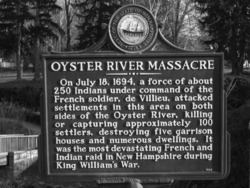Date 18 July 1694 | 104 inhabitants were killed and 27 taken captive unknown | |
 | ||
Francis Drew, Thomas Pickford, John Woodman Claude-Sébastien de Villieu; Louis-Pierre Thury Bomazeen, Captain Nathaniel Similar Raid on Salmon Falls, King William's War, Siege of Fort Nashwaak, Hudson Bay expedition, Raid on Wells | ||
The Raid on Oyster River (also known as the Oyster River Massacre) happened during King William's War, on July 18, 1694, at present-day Durham, New Hampshire.
Contents
Historical context
Massachusetts responded to the Siege of Pemaquid (1689) by sending out 600 men to the border region. Led by Major Jeremiah Swaine of Reading, Massachusetts, the soldiers met on August 28, 1689, and then scoured the region. Despite Swaine's presence, the Natives attacked Oyster River (Durham, New Hampshire) and killed 21 people, taking several others captive.
In 1693 the English at Boston had entered into peace and trade negotiations with the Abenaki tribes in eastern Massachusetts. The French at Quebec under Governor Frontenac wished to disrupt the negotiations and sent Claude-Sébastien de Villieu in the fall of 1693 into present-day Maine, with orders to "place himself at the head of the Acadian Indians and lead them against the English." Villieu spent the winter at Fort Nashwaak. The Indian bands of the region were in general disagreement whether to attack the English or not, but after discussions by Villieu and the support of Father Louis-Pierre Thury and Father Vincent Bigot (at Pentagouet) they went on the offensive.
Raid
The English settlement of Oyster River was attacked by Villieu with about 250 Abenaki Indians, composed of two main groups from the Penobscot and Norridgewock under command of their sagamore Bomazeen (or Bomoseen). A number of Maliseet from Medoctec took part in the attack. The Indian force was divided into two groups to attack the settlement, which was laid out on both sides of the Oyster River. Villieu led the Pentagoet and the Meductic/Nashwaaks. The attack commenced at daybreak, with the small forts quickly falling to the attackers. In all, 104 inhabitants were killed and 27 taken captive, with half the dwellings, including the garrisons, pillaged and burned to the ground. Crops were destroyed and livestock killed, causing famine and destitution for survivors.
Consequences
After the successful raid on Oyster River, Claude-Sébastien de Villieu joined Acadian Governor de Villebon as the commander of Fort Nashwaak, capital of Acadia.
